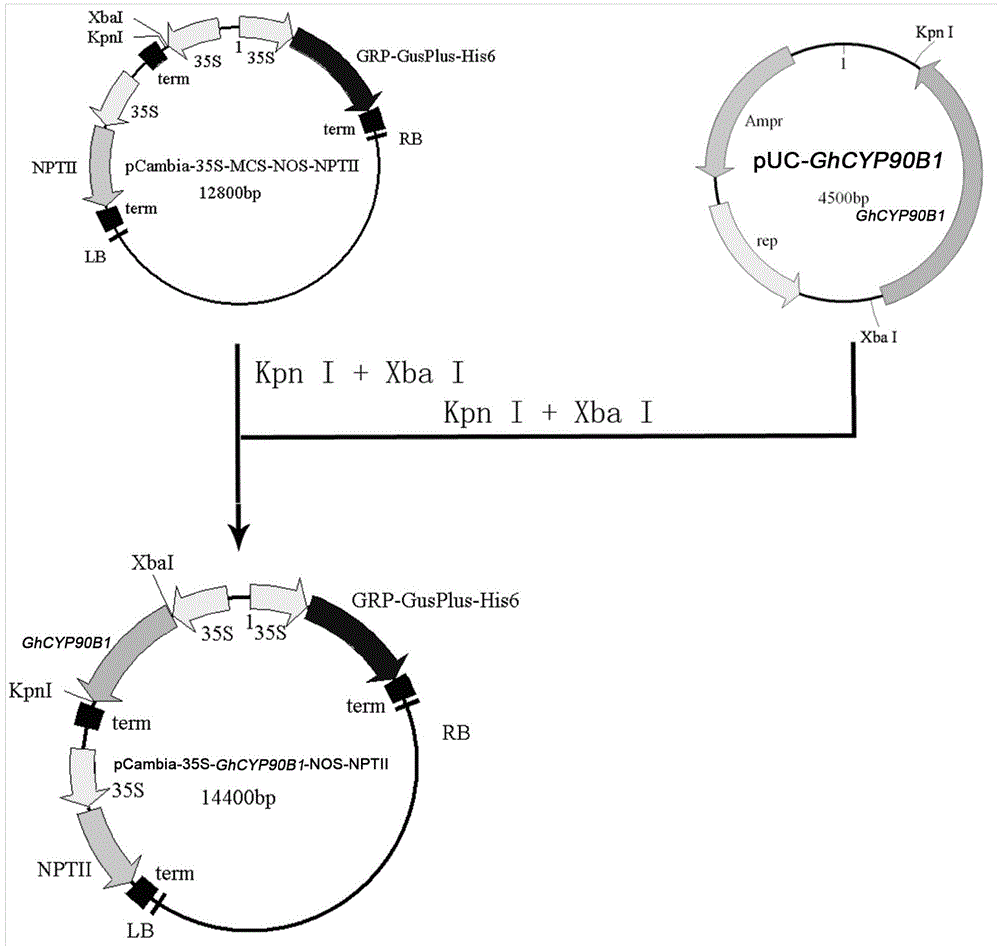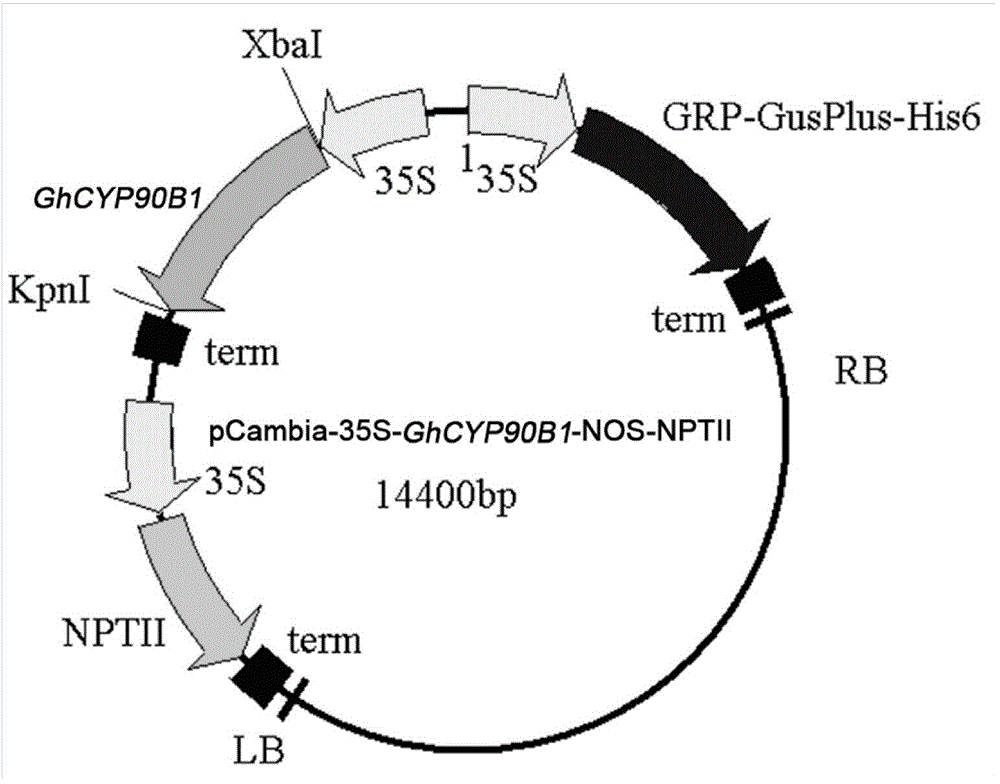Application of cotton steroid C22alpha-hydroxylase gene GhCYP90B1 to improvement of tomato quality
A technology of α-hydroxylase and steroids, which is applied in the field of plant genetic engineering, can solve the problems of low physiological activity and achieve the effects of increased single fruit weight, increased soluble protein and Vc content, and larger fruit
- Summary
- Abstract
- Description
- Claims
- Application Information
AI Technical Summary
Problems solved by technology
Method used
Image
Examples
Embodiment 1
[0042] The cloning of embodiment 1GhCYP90B1 gene sequence
[0043] 1. Extraction of Cotton RNA
[0044] Select about 3g of fresh cotton material, quickly grind it into a fine powder in liquid nitrogen, put it into a 50mL centrifuge tube, add 15ml of 65°C preheated RNA extraction solution (2% CTAB (W / V), 2% PVP (W / V ), 100mmol / L Tris-HCl (pH8.0), 0.5g / L Spermidine, 2.0mol / L NaCl, 2% mercaptoethanol (V / V, added before use)), and mix well by inversion. Water bath at 65°C for 3-10 minutes, during which time mix 2-3 times. Chloroform:isoamyl alcohol (24:1) extracted twice (10,000r / min, room temperature, 5min). Take the supernatant, add 1 / 4 volume of 10mol / L LiCl solution, place at 4°C for 6h, and extract once each with chloroform:isoamyl alcohol (25:24:1) (10,000r / min, room temperature, 5min). Add 2 times the volume of absolute ethanol, and precipitate in a -70°C refrigerator for more than 30 minutes. Centrifuge at 12,000r / min at 4°C for 20min, discard the supernatant. The pre...
Embodiment 2
[0064] Construction of embodiment 2 overexpression vector and genetic transformation of tomato
[0065] 1. Construction of overexpression vector
[0066] The pUC-GhCYP90B1 vector was constructed when cloning the GhCYP90B1 gene, and the GhCYP90B1 fragment on it has been sequenced. The plant expression vector is a transformed pCambia vector (i.e. the pCambia-35S-MCS-NOS-NPT II vector described below), the HPT II gene of the vector is cleaved with XhoI and replaced with the NPT II gene and amplified from the pBI121 vector The primers were designed with XhoI sites at both ends, and the primer sequences were: NPT-1: 5'-CCGCTCGAGCGGGGATCTGGATCGTTTCGCATG-3' (SEQ ID NO.10), NPT-2: 5'-CCGCTCGAGCGGCTCAGAAGAACTCGTCAAGAAG-3' (SEQ ID NO.11 ), restriction enzyme digestion and sequencing results verified the direction of NPT II gene. The CaMV35S promoter and NOS terminator were amplified in the pBI121 vector, and the corresponding restriction sites were also introduced at both ends of the ...
Embodiment 3
[0086] Embodiment 3 detects the expression level of GhCYP90B1 gene in transgenic tomato
[0087] According to the method for extracting cotton RNA in Example 1, the total RNA of transgenic tomato and wild-type tomato leaves was extracted, and a cDNA strand was synthesized. Real-Time PCR was used to analyze the expression of the target gene in the transgenic tomato. The PCR was carried out on a quantitative real-time PCR instrument, and 12.5 μL MIX buffer (including PCR buffer, DNA polymerase, dNTPs and MgCl2) was included in the 25 μL reaction system. , provided by quantitative real-time PCR kit, Bio-Rad). The GhCYP90B1 gene was amplified with primers D4-500 (SEQ ID NO.9) and GhCYP90B1-2 (SEQ ID NO.6). The internal standard was the tomato tubulin gene (LeTUB, DQ205342), and the primer was LeTUB-1 (SEQ ID NO.6). NO.7) and LeTUB-2 (SEQ ID NO.8). The amplification program is: pre-denaturation at 94°C for 3min; 94°C, 30sec; 56°C, 30sec; 72°C, 30sec; the preset cycle number is 35...
PUM
 Login to View More
Login to View More Abstract
Description
Claims
Application Information
 Login to View More
Login to View More - R&D
- Intellectual Property
- Life Sciences
- Materials
- Tech Scout
- Unparalleled Data Quality
- Higher Quality Content
- 60% Fewer Hallucinations
Browse by: Latest US Patents, China's latest patents, Technical Efficacy Thesaurus, Application Domain, Technology Topic, Popular Technical Reports.
© 2025 PatSnap. All rights reserved.Legal|Privacy policy|Modern Slavery Act Transparency Statement|Sitemap|About US| Contact US: help@patsnap.com



